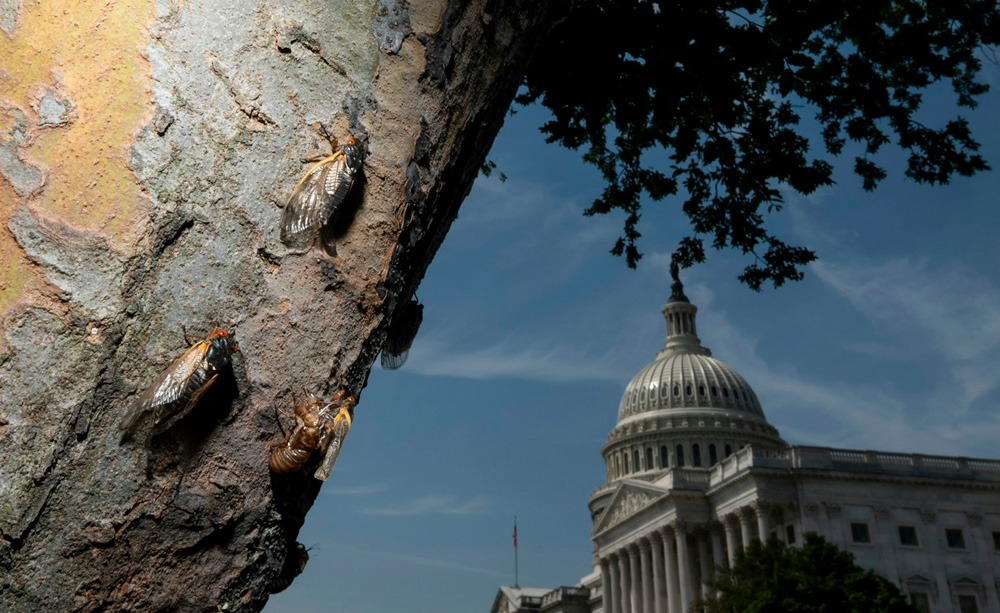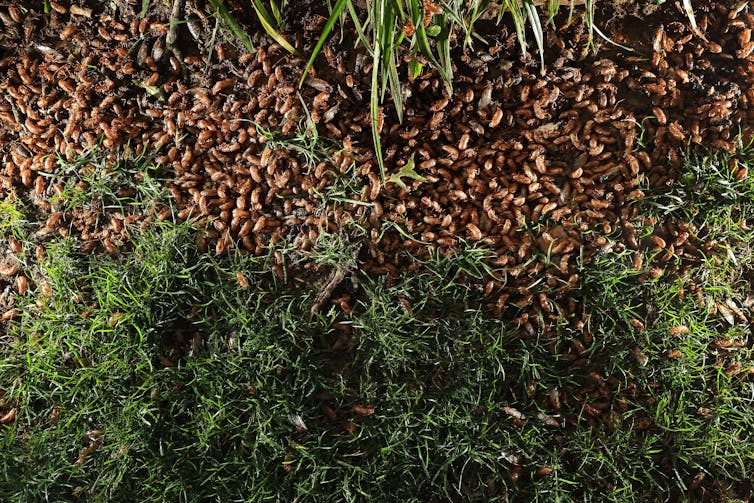
By John Cooley and Chris Simon
In the wake of North America’s recent solar eclipse, another historic natural event is on the horizon. From late April through June 2024, the largest brood of 13-year cicadas, known as Brood XIX, will co-emerge with a midwestern brood of 17-year cicadas, Brood XIII.
This event will affect 17 states, from Maryland west to Iowa and south into Arkansas, Alabama and northern Georgia, the Carolinas, Virginia and Maryland. A co-emergence like this of two specific broods with different life cycles happens only once every 221 years. The last time these two groups emerged together was in 1803, when Thomas Jefferson was president.
For about four weeks, scattered wooded and suburban areas will ring with cicadas’ distinctive whistling, buzzing and chirping mating calls. After mating, each female will lay hundreds of eggs in pencil-size tree branches. Then the adult cicadas will die. Once the eggs hatch, new cicada nymphs will fall from the trees and burrow back underground, starting the cycle again.
There are perhaps 3,000 to 5,000 species of cicadas around the world, but the 13- and 17-year periodical cicadas of the eastern U.S. appear to be unique in combining long juvenile development times underground with synchronized, mass adult emergences. There are two other known periodical cicadas in the world, one in northeast India and one in Fiji, but these have only four-year and eight-year life cycles, respectively.
Periodical cicadas raise many questions for entomologists and the public alike. What do cicadas do underground for 13 or 17 years? Why are their life cycles so long? Why are they synchronized? Will the two broods emerging this spring interact? How can citizen scientists help to document this emergence? And is climate change affecting this wonder of the insect world?
We study periodical cicadas to understand questions about biodiversity, biogeography, behavior and ecology – the evolution, natural history and geographic distribution of life. It’s no accident that the scientific name for periodical 13- and 17-year cicadas is Magicicada, shortened from “magic cicada.”
Ancient visitors
As species, periodical cicadas are older than the forests that they inhabit. Molecular analysis has shown that about 4 million years ago, the ancestor of the current Magicicada species split into two lineages. Some 1.5 million years later, one of those lineages split again. The resulting three lineages are the basis of the modern periodical cicada species groups, Decim, Cassini and Decula.
Early American colonists first encountered periodical cicadas in Massachusetts. The sudden appearance of so many insects reminded them of biblical plagues of locusts, which are a type of grasshopper. That’s how the name “locust” became incorrectly associated with cicadas in North America.
During the 19th century, notable entomologists such as Benjamin Walsh, C.V. Riley and Charles Marlatt worked out the astonishing biology of periodical cicadas. They established that unlike locusts or other grasshoppers, cicadas don’t chew leaves, decimate crops or fly in swarms.
Instead, these insects spend most of their lives out of sight, growing underground and feeding on plant roots as they pass through five juvenile stages. Their synchronized emergences are predictable, occurring on a clockwork schedule of 17 years in the North and 13 years in the South and Mississippi Valley. There are multiple, regional year classes, known as broods.
Each color on this map represents a brood of 13-year or 17-year cicadas, denoted by University of Connecticut researchers observing active cicada choruses. Broods XIII (brown) and XIX (orange) will emerge in 2024. Click on any point to see which brood it belongs to. Source: University of Connecticut, used with permission.
Acting in unison
The key feature of Magicicada biology is that these insects emerge synchronously in huge numbers – as high as 1.5 million per acre. This increases their chances of accomplishing their key mission aboveground: finding mates.
Dense emergences also provide what scientists call a predator-satiation or safety-in-numbers defense. Any predator that feeds on cicadas, whether it’s a fox, squirrel, bat or bird, will eat its fill long before it consumes all of the insects in the area, leaving many survivors behind.
While periodical cicadas largely come out on schedule every 17 or 13 years, often a small group emerges four years early or late. Early-emerging cicadas may be faster-growing individuals that had access to abundant food, and the laggards may be individuals that subsisted with less.
If growing conditions change over time, as is happening now with climate warming, having the ability to make this kind of life cycle switch and come out either four years early in favorable times or four years late in more difficult times becomes important. If a sudden warm or cold phase causes a large number of cicadas to come out off schedule by four years, the insects can emerge in sufficient numbers to satiate predators and shift to a new schedule.
Will climate change shift Magicicada clocks?
As glaciers retreated from what is now the U.S. some 10,000 to 20,000 years ago, periodical cicadas filled eastern forests. Temporary life cycle switching in diverse locations has formed a complex mosaic of broods.
Today there are 12 broods of 17-year periodical cicadas in northeastern deciduous forests, where trees drop leaves in winter. These groups are numbered sequentially and fit together like a giant jigsaw puzzle. In the Southeast and the Mississippi Valley there are three broods of 13-year cicadas.
Because periodical cicadas are sensitive to climate, the patterns of their broods and species reflect climatic shifts. For example, genetic and other data from our work indicate that the 13-year species Magicicada neotredecim, which is found in the upper Mississippi Valley, formed during a previous interglacial period about 200,000 years ago.
As the environment warmed, 17-year cicadas in the area emerged successively, generation after generation, after 13 years underground. Eventually, they permanently shifted to a 13-year cycle.
But it’s not clear whether cicadas can continue to evolve as quickly as humans are altering their environment. Although periodical cicadas prefer forest edges and thrive in suburban areas, they cannot survive deforestation or reproduce successfully in areas without trees.

Chip Somodevilla/Getty Images
Indeed, some broods have already become extinct. In the late 19th century, one Brood (XXI) disappeared from north Florida and Georgia. Another (XI) has been extinct in northeast Connecticut since around 1954, and a third (VII) in upstate New York has shrunk from eight counties to one since mapping first began in the mid-1800s.
Climate change could also have farther-reaching effects. As the U.S. climate warms, longer growing seasons may provide a larger food supply. This may eventually change more 17-year cicadas into 13-year cicadas, just as past warming altered Magicicada neotredecim.
Early emergences occurred in 2017 in Cincinnati and the Baltimore-Washington metro area, and in 1969, 2003 and 2020 in the Chicago metro area, with more individuals participating in successive generations. We hypothesize that this was due to climate warming.
In 2024, 17-year Brood XIII will emerge geographically adjacent to 13-year Brood XIX. However, contrary to some recent media reports, they will not overlap. We know this because we have mapped them in previous generations when they emerged separately. In the area of adjacency, we are not able to tell the two broods apart. They are identical in appearance, song and genetics.
Researchers need detailed high-quality information to track cicada distributions over time. Citizen scientists are key to this effort because periodical cicada populations are so large and their adult emergences last only a few weeks.
Volunteers who want to help document the 2024 emergence can download the Cicada Safari mobile phone app, provide snapshots and follow our research in real time online at www.cicadas.uconn.edu. Cicadas will be hard to ignore if they’re in your area, so why not learn to appreciate them and have fun?




























JimboXYZ says
Trillions of Cicadas will die in 2024, Global Warming, it’s the end of the world. Biden needs to pass legislation to fund saving the Cicadas. Where is Fauci when you need him most, to shut the nation down again ? Wear a mask, get your vaccine booster shot.
Pierre Tristam says
Finally, a little humor from Jimbo.
Joe D says
Florida should consider itself lucky. After growing up in Pa. and Md. most of my life, before retirement, they are an annoying nuisance.
They don’t sting or bite, but the sound is deafening! It’s been compared to the sound of a jet engine taking off ( they aren’t kidding).
Laurel says
Joe D: Where are you in September? The cicadas are here every year, and yes, they are deafening! They sing in waves. A couple start out *singing* and are immediately joined by all in the area.
The article didn’t mention cicada wasps. We watched one drag a huge cicada up an oak tree.